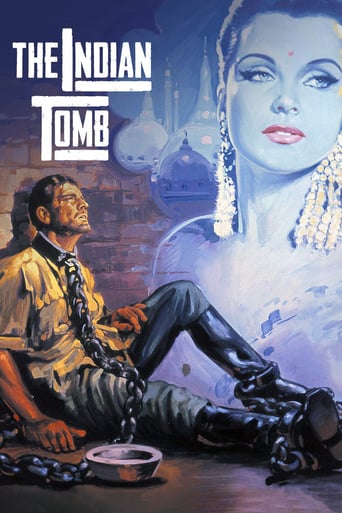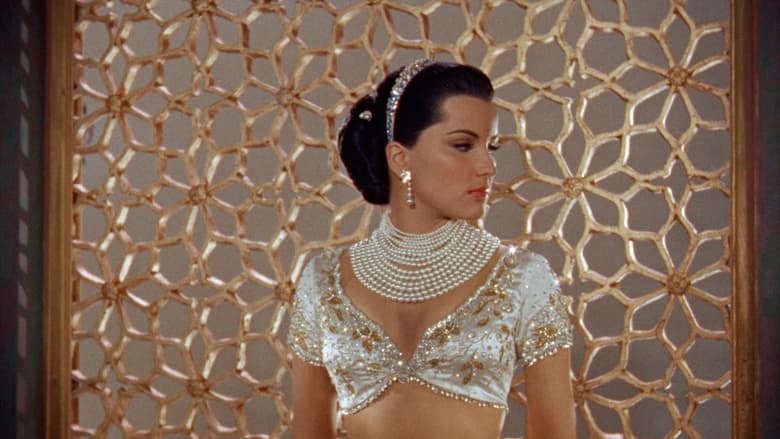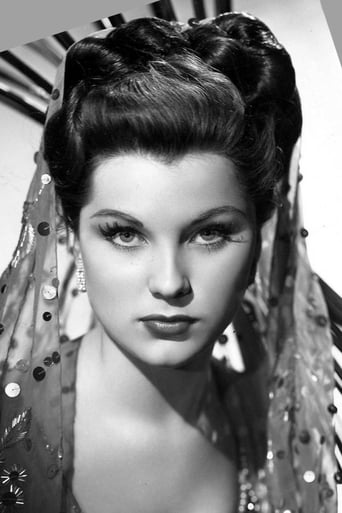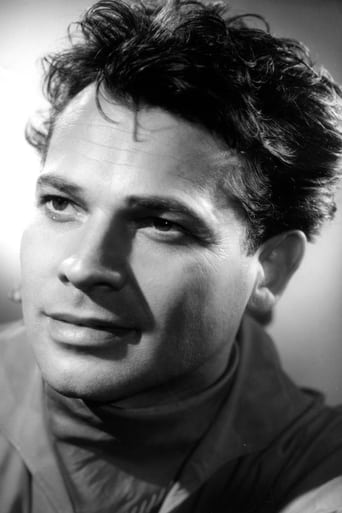The Indian Tomb (1959)
Seetha and Harold Berger are rescued from the desert by a caravan and brought to a small village. However, the greedy owner of the house where they are lodged betrays the law of hospitality and reveals their location to Prince Ramigani. The couple tries to escape but is hunted and captured by Ramigani and his men. Meanwhile Irene Rhode and her husband Walter Rhode suspect that Maharaja Chandra is not telling the truth about Harold's destiny. The conspirator Ramigani forces Seetha to accept to get married with Chandra to provoke the wrath of the priests and get the alliance of Prince Padhu and his army. In the meantime, Harold succeeds in escaping from the dungeon and seeks out Seetha to save her.
Watch Trailer
Cast
Reviews
That was an excellent one.
Simply A Masterpiece
Beautiful, moving film.
Although it has its amusing moments, in eneral the plot does not convince.
This is the continuation of the story begun in "Der Tiger von Eschnapur". This previous film ended with the lovers seemingly on death's door--dying out in the desert after running away from the vengeful Maharaja. Now, shortly after, the pair are recaptured. The beautiful dancer (Debra Paget) is being forced to marry the nasty Maharaja and her lover (Paul Hubschmid) is being held in a dungeon--but she's been told he's dead. In the meantime, the nice engineer's sister and brother-in-law are virtual prisoners of the Maharaja's kindness and they soon realize the man knows more about Hubschmid than he's admitting. And, during all this, there are MANY folks conspiring to depose the Maharaja.The first film was escapist fun. This second one is dreary and slow during too much of the film. Part of it is that it's so talky. Part of it is the best part of the first film was the love story--but Paget and Hubschmid are separated almost this entire film and spend almost no time together. And, part of it is that the script is rather bereft of action--at least until the end of the film. And, when the fighting broke out, it often seemed like it was being performed in slow-motion. Finally, the Maharaja's change of heart at the end made no sense. Where did this come from considering it completely violated who he'd become in the film. The only really good thin about the film is Paget's sexy dancing--which manages to perhaps be even more alluring than it was in the first film! Wow. But otherwise, a rather limp follow-up--and one that should have been fun.By the way, I just about always watch films in their original language with subtitles. On a lark, I decided to leave the English language version on for a few minutes--just to see if they were different. Oddly, the leading man plays a Canadian in the English language version and he's a German in the original film! Perhaps with WWII only a decade and a half back, they thought the film would be more marketable outside Germany if the man was a Canadian. I noticed a few other differences and turned it back to the German language version.
In the end of Der Tiger von Eschnapur the two lovers were in the middle of a sandstorm.Harald Berger (Paul Hubschmid), the German architect and his Indian lover, dancer Seetha (Debra Paget) were chased through the desert by shikaris (cavalry) of Eschnapur's maharajah Chandra (Walter Reyer).They get into a Shiva temple, where a spider weaves a web so the trackers won't look for them in there.But Seetha is caught inside.He has to try and survive alone, and to safe the one he loves.But it's not going to be easy.His sister Irene (Sabine Bethmann) and her husband, architect Walter Rhode (Claus Holm) are suspicious,after Chandra has asked him to build a tomb for Seetha, who is still alive.She won't believe that her brother has died on a tiger hunt.Meanwhile, prince Ramigani (René Deltgen) wants to seize Chandra's throne.Das Indische Grabmal (1959) was the second last film Fritz Lang directed.His Indian epic is based on work he did forty years earlier on a silent version of Das Indische Grabmal.He wrote the screenplay with his wife of the time, Thea von Harbou, who also starred Die Nibelungen movies.It based on Harbou's novel of the same name.Both of these adventure films offer many thrills.The subterranean scenes are very thrilling.And to see Harald chained, trying to fight his way into freedom.It's a very sexy scene where Seetha dances to charm the cobra in that most revealing costume.The conclusion of this story is well told.
Seetha (Debra Paget) and Harold Berger (Paul Hubschmid) are rescued from the desert by a caravan and brought to a small village. However, the greedy owner of the house where they are lodged betrays the law of hospitality and reveals their location to Prince Ramigani (René Deltgen). The couple tries to escape but is hunted and captured by Ramigani and his men. Meanwhile Irene Rhode (Sabine Bethmann) and her husband Walter Rhode (Claus Holm) suspect that Maharaja Chandra (Walter Reyer) is not telling the truth about Harold's destiny. The conspirator Ramigani forces Seetha to accept to get married with Chandra to provoke the wrath of the priests and get the alliance of Prince Padhu (Jochen Brockmann) and his army. In the meantime, Harold succeeds in escaping from the dungeon and seeks out Seetha to save her. "Das Indische Grabmal" is the delightful conclusion of a romantic adventure in the exotic India. This family movie seems to be a matinée with wonderful moments, like for example, the spider building its web and protecting the lovers after the offering of Seetha to her god Shiva; or the sexy dance of Seetha; or the maze in the underground of the palace; or the dead bodies without gore. The colors are splendidly restored in the DVD released in Brazil by Continental in the beautiful locations and sets, and it is possible to see the strings controlling the snake while Seetha is dancing. My vote is eight.Title (Brazil): "Sepulcro Indiano" ("Indian Tomb")
The second part of "der Tiger von Eschnapur" begins with a de rigueur summary .Although it's the same movie divided into two for business concern,"das Indische Grabmal" surpasses its predecessor and makes it sometimes look like a trailer.All promises are fulfilled ;Everything Lang threatened to achieve in "der Tiger " materializes here.Here the two worlds (the luminous world of the maharajah and the subterraneans where the darkest secrets are hidden ) play an equal part .How can't we think of "Metropolis" when the lepers come up the stairs and force their way in the light of day?The maharajah is much more than a comic strip character here.He appears as a tortured man -the actor who plays this monarch is actually a German one,the one who plays count Andrassy is the "Sissi" saga-.Little by little ,we discover that he's in fact the real hero of the story-Mercier is absent during an hour in this part-:his evolution is downright intriguing .At the end of the story he found peace of mind in a completely unexpected way.Remarkable scenes :the spider that spins its web and thus protects the lovers;their enemies seen behind this providential shield.Paget's erotic dance in front of the snake (which echoes to the long scene in the first part when Mercier watches her dancing).And mainly, mainly,these labyrinthine subterraneans which may represent the dark side of the mind .The two worlds (he said that in "die Nibelungen" (1924),there were four worlds!) are a permanent feature in Lang's canon:of course "Metropolis " springs to mind.But think of the underworld of "M";the double life of Andrews in "beyond a reasonable doubt" ;the child's world and the adults' one in "Moonfleet";the "normal "side of life and the secret one beyond the door in the eponymous movie;real life and dream (but where is the frontier?) in "woman in the window" .Fritz Lang's holiday homework is actually his testament.He would do one more movie ("die tausend Augen des Doctor Mabuse"),but it seemed that,like his hero,he had found peace of mind in this movie.You can forget,unless you're a highbrow,his part in Godard's notorious "le mépris".Like John Huston or Joseph Mankiewicz ,Lang finished his career brilliantly.





